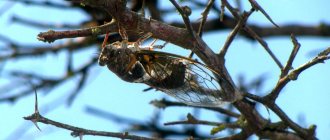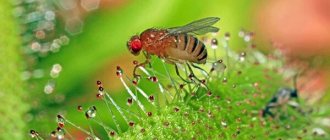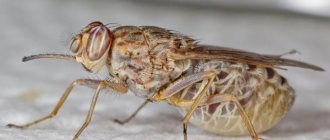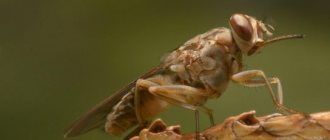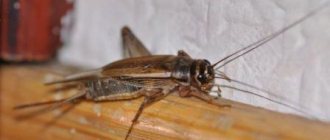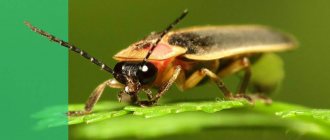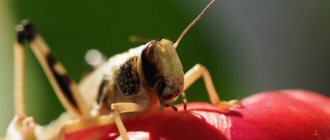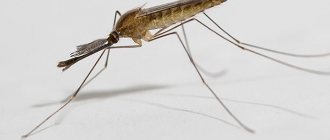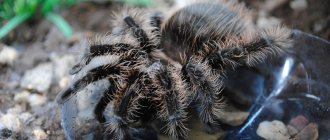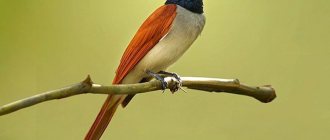It is difficult to resist a violent reaction when you come face to face with an impressively sized centipede in your own home, busily rushing about its business. The first impulse is to get rid of this monster immediately, most likely with the help of a slipper. This cute insect is a flycatcher, a completely harmless peaceful arthropod.
Description of the flycatcher insect
The homeland of this animal is southern Europe, northern Africa and the Middle East. In our latitudes, the flycatcher insect lives in fallen leaves and prefers high humidity and warmth. For this reason, the centipede starts in basements and with the first autumn chill comes out to hunt in our apartments. Yes, yes, this insect is a predator; it is not for nothing that it is also called the common flycatcher. Its diet includes flies, cockroaches, crickets, moths and other household pests. So, even with a repulsive appearance, a centipede can serve well the owners of the house that shelters it.
What does a flycatcher insect look like?
Her frightening appearance is a common cause of women's squeals and children's frightened screams. Common flycatcher insects have a long brown or yellowish body, about 6 cm for an adult centipede, with three dark parallel stripes on the back. Along the body they have thin legs in the number of 4 to 15 pairs, which depends on the age of the individual. This number of limbs provides the insect with incredible speed - up to 40 cm/s.
The hind legs are as long as the nimble whiskers located on the insect’s head and responsible for its coordination, and at their base there are compound, watchful eyes. In addition, the house flycatcher insect has nimble jaws, the task of which is to capture prey and inject poison into its body for further absorption. All this together creates a truly frightening image.
Where does the flycatcher insect live?
The centipede in nature lives in rotten leaves from last year. For the winter, it seeks shelter in cracks of stones or bricks, in the basements of residential buildings or ventilation systems, where it freezes during the period of frost until the first thaw, and then it begins its hunting activity. The common house flycatcher prefers to live in dark, damp and warm places. That’s why basements, bathrooms and kitchens attract her most. You may not even know that a centipede has settled at home and methodically eats cockroaches, because they are awake mainly at night, remaining unnoticed for a long time.
How does the flycatcher insect catch flies?
This number of legs allows the centipede not only to move quickly, but also to hunt effectively. Tenacious hooks on the limbs are another feature that the flycatcher can boast of. The insect stays on the wall as confidently as on the floor, precisely thanks to them. With them, the centipede tightly grasps the prey, brings it to its jaws, with which it pierces the skin of the victim, simultaneously releasing a toxic substance into the wound, which finishes off the unfortunate person.
The house flycatcher insect makes its way into residential buildings closer to autumn, escaping from the cold. At this time, flies, spiders and cockroaches, preparing for hibernation, become slow and clumsy. Therefore, it is not difficult for a centipede to get dinner in a human home, and the home environment gets rid of unwanted insects, so that proximity to a flycatcher can be quite mutually beneficial.
Does the flycatcher insect bite?
The presence of jaws on a centipede immediately raises alarming thoughts. Of course, this predatory insect bites, because this is how it gets its food. A person can also fall under attack if a centipede in his hands feels threatened and needs to defend itself. At the same time, the flycatcher is an insect whose bite is completely harmless to human health and life. The maximum trouble it can cause a person is a burning sensation and minor irritation on the skin.
Signs if you kill a centipede
Unlike many species of insects that live next to people in their homes, centipedes bring very tangible benefits. Being predators, they methodically catch and destroy flies, fleas, crickets, bedbugs, cockroaches, spiders, moths and other pests. Arthropods perfectly see, smell, and also focus on vibrations produced by potential prey. They attack with lightning speed, injecting paralyzing poison, and then eat their prey.
A folk sign associated with centipedes states that under no circumstances should one kill the messenger who brought good news to the house. There are no serious consequences after this act, but, to say the least, it is ugly. From a practical point of view, getting rid of centipedes is illogical, since the voracious arthropods are very successful, completely free and safe (using environmentally friendly methods) in helping to get rid of household pests.
Comment! A centipede seen in a dream foreshadows small but troublesome matters that require a lot of effort and time.
Centipedes happily feed on their close relatives - other arthropods
What causes the flycatcher insect?
Having learned about the centipede's lifestyle, what it eats and what environment it prefers to live in, it is not so difficult to understand why it can appear in a home. At home, the flytrap insect appears only if it discovers that there is something to profit from. A large number of other insects under your roof can also attract a centipede, which will inevitably be tempted by such a hot spot. A basement with high humidity in a private home can also become a source of centipedes, because that’s where they feel most comfortable.
Prevention
Prevention of centipedes:
- carry out regular cleaning;
- ensure that no puddles form near the pipes;
- make cosmetic repairs if necessary;
- do not litter the adjacent area;
- seal all holes and cracks in the walls to prevent unwanted neighbors.
Stories from our readers!
“We have always used fertilizers and top dressing in our garden. The neighbor said he was soaking the seeds using new fertilizer. The seedlings grow strong and strong.
We ordered and followed the instructions. Wonderful results! We didn't expect this! We harvested a wonderful harvest this year, and now we will always use only this product. I recommend trying it.”
How is the flycatcher insect useful?
Although the very fact of the appearance of such monsters under the same roof as you cannot please you, it also has an unobvious advantage. The flycatcher is a beneficial insect that will rid any room of unnecessary pests. This is a natural and non-chemical insecticide given to us by nature. So, if you had to suffer from an invasion of flies or cockroaches, which is why centipedes also appeared in the house, just give them time - the house will inevitably clear itself, and the house flytrap insect will become your favorite.
About worms
The worm can predict the weather more accurately than a barometer
- If earthworms climb to the surface, the weather will turn bad.
- If you manage to catch a worm in the process of emerging from the ground, pack your bags for a long trip.
- If in the fall there are a lot of worms in the puddles after rain, the winter will be snowy and without severe frosts.
- If a worm crawls across someone's path, that person will soon learn incredible news.
- If you step on a worm, you will have no luck for the rest of the day.
- If you kill him purposefully, your luck will run out for a long time. All that remains is to find out whether fishing is considered murder.
Previously, when an English fisherman happened to injure his finger while fishing, he immediately pressed a worm from a jar of bait to the wound, and then threw it into the river. It was believed that the strange healer would draw out all the bad things from the cut, and the wound would not fester. And don’t rush to wince! Nowadays, even in developed countries, there is a method of cleansing wounds from dead tissue using maggots. Of course, it is built on a different principle and requires constant medical supervision, but the possibility of using the worm for medical purposes is an undeniable fact.
Why is the flycatcher insect dangerous?
For obvious reasons, the appearance of centipedes in the house does not cause joyful emotions. Is the flytrap insect dangerous for humans? This is a question that worries anyone who sees it. As already mentioned, the centipede’s venom is not harmful to people, and besides, its jaws are unlikely to be able to bite through thick human skin. However, if an adult still succeeds, then get ready for unpleasant sensations akin to a bee sting. In this case, you need to take the following measures:
- wash the bite site with soapy water;
- treat the wound with alcohol or peroxide;
- cool the swelling by applying ice or something cold;
- if the swelling increases, take something against allergies.
Origin
The Venus flytrap (see photo) was discovered by Arthur Dobs in 1736, who compared the plant to iron traps used to hunt foxes. It is thanks to its unusual leaves that the flower quickly gained great popularity and aroused the interest of almost everyone.
The flycatcher was later imported to England. In botany, the plant already officially occupied its niche in 1970 thanks to John Ellis, a famous British naturalist.
flycatcher
From its natural habitat, namely wetlands in North and South Carolina (USA), the Venus flytrap has moved to many window sills and greenhouses around the world. In these areas, summers are moderately warm and dry, while winters, on the contrary, are quite cold.
Charles Darwin himself paid great attention to this plant, who studied its abilities and was one of the first to reveal some of its secrets. The appearance of the flycatcher's mouth in order to catch and digest small organisms was only a hypothesis until recently
Soon the curtain rose and the flower appeared in all its glory.
When an insect first touches the flytrap leaves, the plant does not react in any way, it simply goes into standby mode, which lasts about 20 seconds. The carnivorous plant is able to avoid unnecessary “activation” of the trap at the slightest breath of wind or dust particles falling on the leaves.
Homeland of the flycatcher
A team of German biologists went even further in their research. Using molecular biological techniques, they determined that the photosynthetic particles in the plant's leaves are not very different from standard leaves. This is not such an interesting result, but it has its weight in botany, since it is one of the few pieces of evidence that the flycatcher's mouth most likely evolved from its leaves.
Why can't you kill the flycatcher insect?
The first impulse when looking at a house centipede is to swat it and forget about it. However, you should not rush to harm nature without special reasons. A common flycatcher in an apartment is not the worst guest, given the fact that it:
- does not harm humans and domestic animals;
- does not pollute the space with the products of its vital activity;
- destroys cockroaches, moths, spiders and other uninvited guests;
- prevents their occurrence in the future.
Why take a sin on the soul, even such an insignificant one, by killing a peaceful living creature? It is clear that few people can calmly leave the centipede and continue to crawl along their walls. We recommend that you simply take a jar, carefully scoop the insect into it and take it out into the yard. Considering how long the flycatcher insect lives (about 6 years), it will still have many more houses cleared of unwanted cockroach flies.
Appearance and features
Photo: What a flycatcher looks like
As mentioned earlier, an adult flycatcher can be up to 6 cm long. It simultaneously looks like a very hairy spider, a worm or a centipede. Its body color varies from yellowish, brownish to grayish with contrasting purple or bluish stripes running along the entire back. Her long legs also have stripes. The newborn centipede has only four body segments and a corresponding number of pairs of legs.
The flycatcher has two tiny facet-type eyes on its head, which provide it with excellent, almost all-round visibility. There are also rather long mustaches, consisting of many segments, the number of which can reach six hundred. These antennae are very sensitive and can detect many parameters of the external environment, as well as the approach of danger.
Thanks to the large number of legs and the mobility of all body segments, the centipede is capable of running very quickly. Its movement speed can reach 45-50 cm/sec. The most “multifunctional” are the front legs of the flycatcher. They allow her to both run at a fairly high speed, unusual for other insects, and firmly hold the caught victim, and also serve as reliable protection in the event of an attack by enemies.
Now you know what a flycatcher looks like. Let's see where this unusual insect is found.
How to get rid of a flytrap?
Do not rush to use insecticides to expel centipedes. They are not healthy, and less drastic measures may even be more effective in this case. So, if a flycatcher insect was found in the house, you need to:
- First, just carefully take the centipede outside: most likely, it appeared in the house alone; they rarely settle in one place with entire broods.
- Take measures to reduce the total number of insects in the house: install mosquito nets, maintain cleanliness, exterminate cockroaches. Without the prospect of finding food, the flycatcher insect will not even look in the direction of your home.
- Monitor the level of humidity in the premises: drain the basement, set up a ventilation system in the bathroom. The centipede does not like dry rooms, preferring moisture.
- If for some reason all of the above did not help, only then bring into battle the heavy artillery - insecticides or boric acid.
How to poison, remove a centipede from a house or apartment forever: means of control, poison
You cannot poison centipedes; throw them into wet leaves outside the window. You cannot kill or poison centipedes with various means because of their small number on our Earth . Usually one or several centipedes can wander into a home, and their reproduction occurs in nature.
If you are uncomfortable with a flycatcher, you can catch it in a jar and release it outside in the spring or summer.
Flycatcher insect - keeping in a container
For lovers of exotic pets, the centipede is just the thing. Being completely harmless, it will decorate any indoor terrarium. The flytrap insect can be kept in an apartment in a plastic food container or in a special aquarium. In addition, it would be interesting to house a whole colony of individuals and watch their growth, development and offspring. Just keep in mind that it is not recommended to keep more than six centipedes together. It is better to generally limit yourself to five insects in one container - this number will be optimal for their comfortable existence.
About caterpillars
Once upon a time in Japan they worshiped a caterpillar god!
- In Russia, England and the countries of the East, there is one common sign: if you see a hairy caterpillar, throw it over your left shoulder behind your back, and happiness will come. For the same reason, you cannot crush or otherwise exterminate an insect. Who wants to interfere with their happiness?
- In Japan, such a caterpillar was called the “storm dog” and they claimed that it was protected by the gods. It was believed that the hairy insects appeared in abundance on the grass before heavy rains with thunder and lightning.
- If a person with fever keeps a caterpillar with him, the disease will subside. For whooping cough, they used an equally original remedy, hanging a woven bag with crawling creatures around the neck.
An unexpected belief: if a woman approaches a caterpillar during her “critical days,” she will die.
Flycatcher insect - care
The centipede is a very unusual pet, which, however, also requires proper care. When you get a common flycatcher at home, be sure to take care of the following:
- Sufficient amount of space
. A colony of five centipedes needs a container with a volume of about 30 cm³. - Suitable filler
. The bottom of the container must be covered with a substrate that retains liquid well. Coconut will do. - Hydration
. In a dry environment, flycatchers die, so you need to periodically spray the substrate and not let it dry out. - Handle with care
. Centipedes are very fragile creatures, so you need to handle them very carefully so as not to inadvertently break one of the legs. - Suitable food
. As practice has shown, flycatchers even eat bread crumbs, but their more common diet is somewhat different.
Diseases and pests
- Surprisingly, a plant that eats insects can also suffer from them. For example, an aphid, having settled in a trap and sucking out the juice, deforms it, and the trap stops functioning. To combat aphids, you need to use aerosol insecticides, which are sold in flower shops.
- In dry conditions, spider mites can appear on Dionea. You can get rid of it by treating it three times with an acaricide solution at intervals of a week. In the future, the humidity needs to be increased. Spider mites cannot tolerate excess moisture.
Due to the increased humidity of constantly wet soil, the flycatcher is susceptible to various fungal diseases:
- If a black coating appears on the leaves of the plant, then most likely it is a sooty fungus infection;
- Gray rot appears as gray fluff. All infected parts must be removed immediately;
- If the trap captures a large insect, it cannot digest it and begins to rot. If you notice blackness appearing on a closed trap, it will have to be removed.
The following drugs are recommended for use: Fitosporin M paste, Fundazol for fungal diseases, and Aktara for small insects (aphids, mites).
Fighting a centipede
The insect's body has a very unattractive appearance, so they try to drive it out of the room.
- As a preventative measure, dry the wettest places, destroy all kinds of insects that provide food for the flycatcher, and seal cracks in the walls.
- The centipede does not live in colonies; it leads an independent lifestyle. If you wish, you can catch it and take it out of the room.
If the above methods do not bring the desired result, they resort to chemical methods.
- Artificial and natural pesticides are a good method of protection against these centipedes. You can try using boric acid in your home. During work, be sure to use personal protective equipment: masks, respirators and gloves.
- It is possible to attract specialists to use smoke preparations. These products do not harm humans; they are directed only against insects. Furniture surfaces and clothing are not affected by the treatment.
Surprisingly, the number of flycatchers is constantly decreasing, especially in the mountains of Crimea. The flycatcher, as an endangered animal, is listed in the Red Book of Ukraine.
Interesting behavior
The flycatcher makes good use of its long legs. Can move at alarming speeds - the equivalent of over 64 kilometers/hour in human terms. This will scare even the most die-hard arthropod lover. Athleticism doesn't have to scare you. The house flycatcher is simply well equipped to stalk and catch prey.
Oddly enough, the severed leg will continue to move for several minutes after its owner leaves the stage. They shed even as adults and regenerate lost limbs.
They feed on spiders, bedbugs, termites, cockroaches, silverfish, ants, and other domestic arthropods. The poison is secreted through the forcipules. Not through the lower jaw, so they burn and do not bite. These are night hunters.
Despite their developed eyes, they rely on their whiskers to hunt. The antennae are sensitive to both odors and tactile information. They use mandibles and legs to hold prey. Thus, they can deal with several small insects at the same time.
To catch prey, they either jump on it or use their legs in a technique described as a "lasso". The use of legs to subdue prey is also described.
We suggest you read: How do worms get out of the human body?
They have adapted their feeding pattern to the type of danger the prey may pose to them. For wasps, retreat after applying the poison to give it time to take effect.
Reproduction
Seeds
During flowering, artificial pollination must be carried out using a cotton swab or a soft brush. If pollination is successful, small seed boxes are formed. After three months, the seeds are ready for sowing. Seeds quickly lose their viability - so you need to sow right away. You can also purchase ready-made seeds.
- Seeds need special preparation. To do this, you need to take a fungicide solution, moisten a cotton pad or cloth with it, place it in a tight, airtight package, and close it to maintain high humidity. Then the seeds in the package are put into the refrigerator for 5 weeks. Periodically moisten them with a fungicide solution and make sure that mold does not appear. Seeds should not swell or germinate.
- Then the seeds are scattered over the surface of the prepared soil, consisting of 70% sphagnum and 30% sand, without covering. The substrate must be watered with a fungicide diluted in distilled water at room temperature;
- Cover with film or glass to create a small greenhouse. It is placed under bright diffused light.
- The temperature should be between 24-29 degrees;
- Check the soil moisture all the time, and if necessary, moisten it on top of spraying from a spray bottle;
- Shoots will appear in two to three weeks. You have to wait the same amount of time before planting the seedlings in separate pots;
- It takes about 5 years for a Venus flytrap to become an adult plant.
Cuttings
If you want to propagate a flycatcher by cuttings, you need to cut off the leaves of the plant, treat the sections with heteroauxin, and plant them in soil (the composition of the soil is the same as for a greenhouse). The planted leaf should be covered with a transparent plastic cup. The signal that the plant has taken root will be the growth around the mother leaf. The only disadvantage of this method of propagating flycatchers is the frequent damage to the leaf by mold fungi.
Dividing the bush
Most often, the plant is propagated by transplantation. After washing the roots, carefully separate the young rosettes from the old bush. In this way, the old plant is renewed and young rosettes are obtained for propagation. They are planted in separate pots and placed in trays with water.
What to do if you are bitten?
The centipede rarely attacks itself, but if this happens, you need to know what to do if it bites.
- First, you need to thoroughly wash the bite site with soap (preferably household soap), and then treat it with alcohol.
- Apply a sterile bandage.
- Rest more and drink fluids so that the poison leaves the body faster.
- Contact your doctor.
Under no circumstances should you drink alcohol. It speeds up the metabolism, which causes the poison to spread faster throughout the body, which leads to a worsening of the condition.
Symptoms
The main symptoms after a scolopendra bite are as follows:
- swelling and redness at the site of the bite;
- pain (can be compared to a hornet sting);
- increased temperature (sometimes up to 39 degrees);
- itching;
- general intoxication of the body.
Important! Symptoms may persist for 1-2 days, so it is important to monitor the condition and consult a doctor if necessary.
In most cases, scolopendra venom is not fatal. This is only possible if a person is allergic to some component of the poison or has cardiovascular diseases. However, symptoms can usually be relieved if you go to the hospital in a timely manner.
It is worth noting that domestic scolopendras (flycatchers) do not cause such symptoms. If they sting, only slight redness and a burning sensation may appear at the site of the lesion.
Female centipedes are more poisonous than males. Moreover, they are more active and aggressive, so they attack more often.
How to protect yourself from scolopendra?
Most often, scolopendras attack people in nature, climbing into tents and getting into clothes. Therefore, it is very important to know how to protect yourself from scolopendra in the fresh air.
- Close your tent carefully and check for insects before climbing into it.
- Carefully inspect clothing and shoes.
- Do not go outdoors in the dark.
- Carefully lift branches and stones.
If a scolopendra bites a child or a pregnant woman, you should definitely consult a doctor!
What should you not do after being bitten?
There are some things you should not do after being bitten by a scolopendra. The most important thing is that you should not cut the bite site in the hope of getting rid of the poison. Also, do not apply a tourniquet, as this will lead to stagnation of blood and even greater problems. Do not try to catch up and kill the scolopendra.
Closing mechanism
The top of each side of the Venus flytrap trap is colored with anthocyanins, pigments that give the surface of the trap a red color. This coloring is the main bait for insects in this plant. The trap cells also secrete a sticky substance, which is a type of protein. After the insect crawls into the trap, it begins to flounder on the slippery and sticky surface, greedily licking off the substance, touching the trigger hairs that signal the trap to slam shut.
The trap closing mechanism of the Venus flytrap can be divided into four main phases:
- Initial slamming.
- Compression phase.
- Sealing phase.
- Re-opening phase.
The "descent hairs" are indicators for the plant, which by their vibrations determines that potential prey is trapped. If two hairs are touched at once or one hair twice in a row within 30 seconds, the trap slams shut in a tenth of a second.
The slamming motion of a Venus flytrap is one of the fastest movements that plants are capable of. The amount of time it takes for Dionaea muscipula to slam shut varies greatly depending on ambient temperature, light, plant health, and other factors. However, the trap of a healthy plant in warm conditions slams shut very quickly.
Recent research conducted in 2005 by Harvard scientists shows that the Venus flytrap's trap slamming mechanism is based on biochemical and elastic processes. They cause the leaf tissue to stretch to the point of instability, and after touching the hairs, the plant instantly pumps water into the leaf, causing slamming.
